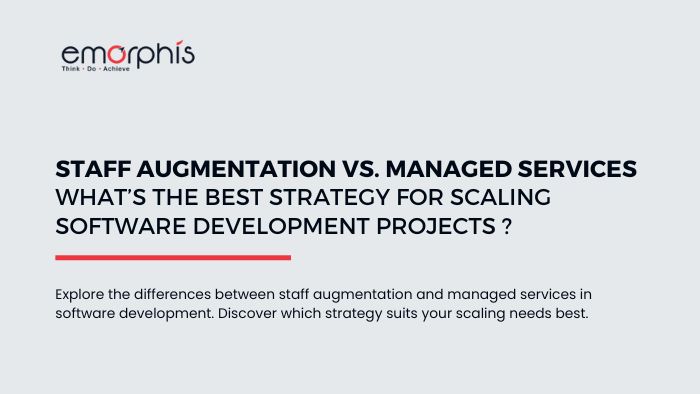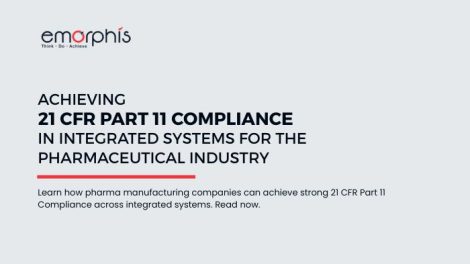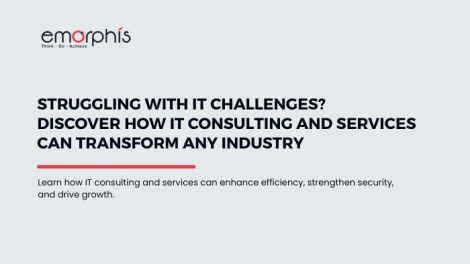In today’s fast-paced world of software development, companies are constantly looking for efficient ways to scale their operations. Two popular strategies often debated are Staff Augmentation vs. Managed Services. Both options help businesses extend their development capabilities, but they work in very different ways. So, how do you know which is the right choice for your business? Let’s break it down and explore the key differences between Staff Augmentation vs. Managed Services, so you can make an informed decision.
What is Staff Augmentation?
Before we dive into the Staff Augmentation vs. Managed Services comparison, it’s essential to understand what staff augmentation really is. Staff augmentation involves bringing external developers or professionals into your existing team to fill skill gaps or meet project demands. These professionals work alongside your internal staff as part of your team but are employed by an external provider.
Key Features of Staff Augmentation:
- Flexibility: You can scale your team up or down based on project needs.
- Control: The augmented staff is integrated with your existing team, giving you full control over project execution.
- Temporary or Long-Term: Staff augmentation can be used for short-term tasks or long-term projects depending on your business needs.
For businesses looking to maintain control over their projects while supplementing their teams with specialized talent, staff augmentation can be a great choice. However, this isn’t the only solution available, which brings us to the other side of the Staff Augmentation vs. Managed Services debate.
What are Managed Services?
On the other hand, managed services involve outsourcing the entire responsibility for a specific function or project to a third-party provider. The managed services provider takes complete ownership of the project’s execution, including managing the team, resources, and ensuring deliverables are met on time.
Key Features of Managed Services:
- End-to-End Responsibility: The managed services provider handles everything from planning to execution.
- Less Control for the Client: Since the provider manages the project, the client has less direct control but enjoys less operational stress.
- Long-Term Partnerships: Managed services are often used for ongoing needs, such as software maintenance or large, complex projects that require continuous oversight.
In comparing Staff Augmentation vs. Managed Services, the primary difference lies in who manages the project and the level of control the client has over day-to-day operations. Now that we’ve defined both models, let’s dive into the key differences between Staff Augmentation vs. Managed Services.
Market Size
In 2023, the market for IT staff augmentation and managed services was valued at approximately USD 299 billion. It is projected to grow to USD 1,072 billion by 2032, with a compound annual growth rate (CAGR) of around 13.7% from 2023 to 2032.
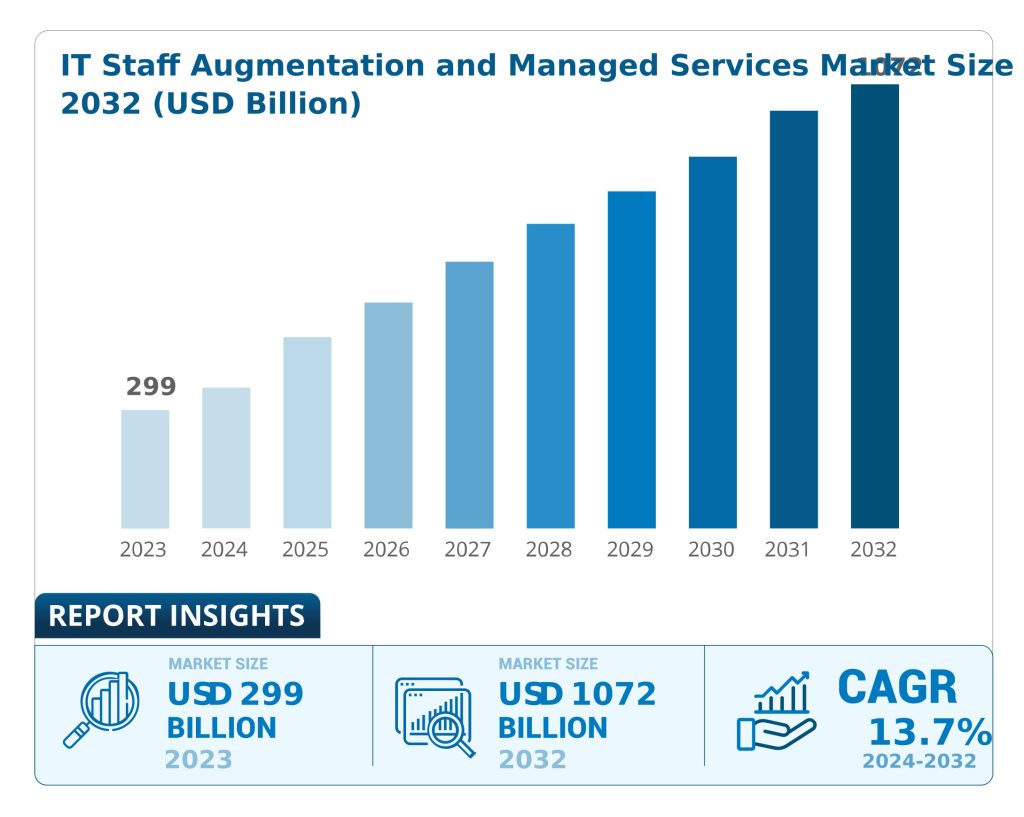
The IT staff augmentation and managed services market is a dynamic sector within technology, encompassing various technical solutions that support company performance and meet IT requirements. The primary function of staff augmentation is to enhance internal teams with temporary external experts who possess specific skill sets, particularly for project-related tasks. On the other hand, managed services provide continuous support and maintenance for IT systems, applications, and infrastructure, typically outsourced to third-party providers. These services also enable businesses to achieve flexibility, scalability, and cost-efficiency in their IT operations, allowing them to leverage external expertise and resources to optimize their performance.
According to a report from Grand View Research, the global IT professional services market was valued at approximately USD 870.05 billion in 2023. It is projected to expand at a compound annual growth rate (CAGR) of 9.5% from 2024 to 2030.
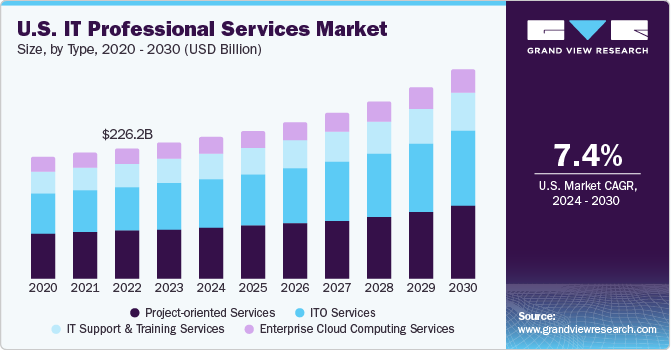
In 2023, technology companies dominated the IT professional services market with a 43.8% share, utilizing data analytics and IT services to enhance operations, particularly in Technology as a Service (TaaS). The COVID-19 pandemic accelerated digital transformation, boosting this segment’s growth.
The marketing and communication companies segment is expected to grow at a 10.9% CAGR, driven by the need for market research, website analysis, and reputation management through IT professional services, alongside the rise of digital media and improved customer experiences.
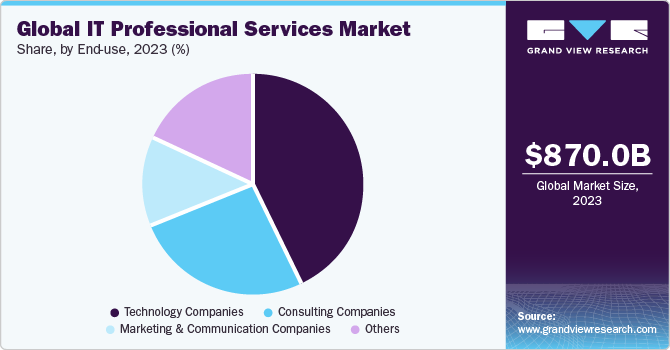
15 Key Differences Between Staff Augmentation vs. Managed Services
1. Control Over Projects and Teams
In Staff Augmentation, you have full control over the team and the project. The augmented staff works directly with your internal team, and you can oversee daily tasks, priorities, and decision-making. In contrast, Managed Services shifts the responsibility to the service provider. They manage the project end-to-end, and you take a more hands-off approach, focusing only on the outcomes.
2. Expertise and Skill Sets
Staff Augmentation allows you to hire specific experts to fill short-term gaps or enhance your team’s capabilities furthermore for a particular project. Moreover, you select individuals based on your exact needs. In Managed Services, the service provider assembles a complete team with the necessary skills to deliver the project, also, providing a broader and more diverse skill set. This can furthermore, include project management, development, testing, and maintenance.
3. Cost Structure and Budget Management
With Staff Augmentation, costs are usually more flexible, as you pay based on hours or days worked by the augmented staff. This allows for a more dynamic budget that can adapt to project needs. In Managed Services, costs are generally fixed, as the service provider delivers a complete solution for an agreed-upon price. This can help with long-term budget planning but may come with higher upfront costs.
4. Flexibility and Scalability
Staff Augmentation is highly flexible. You can scale your team up or down quickly based on your project’s current phase or needs. For instance, during peak times, you can add more staff, and when demand decreases, you can reduce the team size. On the other hand, Managed Services are less flexible since they operate under a contract with a defined scope. Scaling up or modifying the service often requires renegotiation of terms.
5. Responsibility and Accountability
With Staff Augmentation, your internal team retains full responsibility for the success or failure of the project. Moreover, the augmented staff integrates into your existing structure, and management remains in your hands. In Managed Services, the service provider assumes full accountability for delivering the agreed results. Also, they are responsible for managing resources, processes, and project risks, allowing you to focus on strategic decisions.

6. Onboarding and Integration
Staff Augmentation requires onboarding, as the augmented team members need to understand your internal processes, tools, and workflows. They may take some time to fully integrate into your existing team and become productive. In contrast, with Managed Services, the onboarding is limited to aligning the service provider with your goals. The provider handles all internal team dynamics, so you don’t have to worry about training or onboarding individual members.
7. Project Duration and Commitment
Staff Augmentation is often more suitable for short-term projects or temporary needs, such as filling a talent gap or accelerating a development phase. Once the project is complete, the contract with the augmented staff typically ends. On the other hand, Managed Services are better suited for long-term commitments where you need continuous support and maintenance, such as ongoing software management or infrastructure monitoring.
8. Quality Control
In the Staff Augmentation model, you maintain direct control over quality standards. You can implement your own processes, tools, and quality checks to ensure the project meets your company’s standards. In Managed Services, the provider controls quality. While they may follow industry standards, you have less oversight over their internal processes. It’s crucial to select a managed services provider with a proven track record of quality.
9. Communication and Collaboration
In Staff Augmentation, communication is more direct, as the augmented staff is integrated into your team. They follow your communication style, tools, and processes, which can make collaboration smoother. In Managed Services, communication is typically formalized and more structured through periodic reports or meetings. You communicate primarily with the service provider’s project manager rather than the individual team members.
10. Risk Management
With Staff Augmentation, the risks associated with project delays, inefficiencies, or mismanagement fall on your internal team. You are responsible for risk mitigation. However, in Managed Services, the service provider assumes the risks tied to project delivery. They are responsible for meeting deadlines, handling setbacks, and ensuring the project is completed successfully.

11. Innovation and Proactivity
Staff Augmentation offers less room for proactivity from external resources, as the augmented staff follows the direction and goals set by your in-house management. They are also brought in to execute, not innovate. In Managed Services, the provider often brings their expertise and industry insights, proposing innovative solutions, proactive problem-solving, and also, process improvements based on their experience with similar projects.
12. Cultural Fit
Staff Augmentation requires external professionals to integrate with your company culture, as they work directly with your internal team. This can be a challenge if there’s a cultural mismatch, but it also allows you to have more control over the work environment. Managed Services, on the other hand, may have less emphasis on cultural fit since the external team works separately and may not need to adapt to your company’s day-to-day culture.
13. Speed of Deployment
Staff Augmentation generally allows for quicker deployment of talent, as you can hire individuals with specific skill sets and integrate them into your team swiftly. This model works well when you need to add personnel quickly to meet a tight deadline. In Managed Services, the provider needs more time to set up the team and framework, as they take full ownership of the project, which can slow down the initial start.
14. Resource Availability
In Staff Augmentation, resource availability depends on your ability to find the right talent. If the specific skill sets you need are scarce, it can delay the hiring process. Managed Service providers typically have a large pool of professionals and can allocate the required resources without much delay, making it easier to find the expertise you need quickly.
15. Legal and Compliance Considerations
With Staff Augmentation, you handle legal responsibilities such as contracts, intellectual property rights, and compliance issues, as the augmented staff operates within your team. In Managed Services, the provider takes on much of the legal responsibility, including handling IP, data security, and regulatory compliance, reducing your burden. However, you still need to ensure the provider adheres to your industry’s specific compliance requirements.

When to Choose Staff Augmentation?
Staff augmentation is ideal for businesses that need additional team members for a short period or require niche expertise that is not available in-house. It’s also a great solution for companies looking to maintain full control over the development process. If you have a strong internal management team but just need extra hands, staff augmentation can help you scale up without long-term commitment.
When comparing Staff Augmentation vs. Managed Services, choose staff augmentation when:
- You need temporary talent to meet project deadlines.
- Want to keep complete control over project management.
- You have the in-house expertise to manage the overall project.
When to Choose Managed Services?
On the flip side of the Staff Augmentation vs. Managed Services discussion, managed services are best suited for companies looking for a more hands-off approach. Managed services allow you to outsource the entire development process to a trusted partner, making it perfect for projects that require a long-term commitment or where internal management might not have the expertise to lead.
Consider managed services when:
- You want to outsource the entire project management process.
- Need a dedicated team to handle large, complex, or ongoing projects.
- You prefer predictable costs and less operational oversight.
Which Model is Best for Your Business?
The choice between Staff Augmentation vs. Managed Services ultimately depends on your business needs. If you value control, and flexibility, and have a robust internal management team, staff augmentation is the better option. However, if you prefer a full-service solution with less operational involvement, managed services might be the right fit.
Many companies actually use a hybrid approach, combining both models to balance control and responsibility. For instance, you could augment your team for immediate needs while outsourcing other parts of the project to managed services.
Conclusion
In the end, both Staff Augmentation vs. Managed Services have their unique advantages. Staff augmentation offers flexibility and control, making it great for businesses with strong management teams that need extra hands. Managed services, on the other hand, provide a more comprehensive solution, ideal for businesses looking to outsource long-term or complex projects.
Choosing the right approach will depend on your specific needs, budget, and desired level of involvement. As you weigh Staff Augmentation vs. Managed Services, consider your project goals and resources to make the best decision for your business.
Further, click to read Why Choose IT Outsourcing Services for Your Project?



